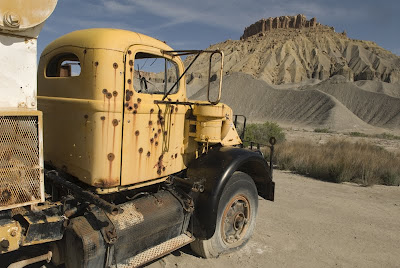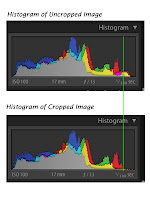
I have selected a photo that I took on drive between Capitol Reef National Park and Moab, Utah. The photo has been hanging around my hard drive for a few years, but I have not really done much with it. I have always liked the photograph, but in its RAW stage, the image just really did not do much for me.
Currently, as most of you know, I use Lightroom 2.4, which I believe is one great program that has enhanced my post processing workflow. If you do not use Lightroom, rest assured, you can do the same things that I do in Lightroom using Camera RAW.
My first post-processing task is to do an assessment of the photograph by asking myself a few questions. Why did I take the photo? What was my main interest in the scene when I decided to take the photo? What is the most important aspect of the photo? Are there any distracting-elements within the photo? Is the color correct?
As I look at the photo, I noticed that it just does not have the details than I remember. So, bringing back the details is definitely a priority in my post-processing. I also do not like my framing. The left side of the photo contains details that really do not add to the image. Consequently, cropping is definitely in order. Here, I need to say that I am not a fan of the 2x3 format that is native to DSLRs (due to the sensor size). As a result, I often look to crop my photos.


Most people do not crop their photos until late in the post-processing workflow. Cropping is one of my first steps and I usually do it in Lightroom because it is nondestructive process, which means I can redo it if I later decide that I do not like the crop. Why is cropping one of my first steps? Because I want to look only at the part of the photograph that I intend on using and the histogram will then show me only information about the “cropped image” not the entire image. This makes the histogram much more useful as I proceed in my post processing work. As you compare the uncropped and cropped histograms you will notice a portion of the uncropped bright areas are gone from the cropped histogram.
Enjoy and don’t forget to ask any questions you might have along the way. I will do my best to revise my next posting to accommodate the questions this week.
Camera settings: Nikon D200, Nikon 28-70mm f/2.8 at 17mm (effective 25mm), shot at ISO 100, f/13 and 1/100th of a second on a tripod.
Ok, I am with you on the post processing. But the cropping is where I tend to get hung up. You say you don't like the 2x3 so what is it you tend to do? Do you set for one particular crop in order to get different size prints? I feel like I am missing something pretty basic.
ReplyDeleteIf you think about the "old" photographic masters, they used cameras that were generally more along the lines of 4x5 rather than 2x3. If you go to most frame stores and look at pre-cut mats, you will generally find that they are usually 5x7, 8x10, 11x17 or 16x20--which is more along the traditional 4x5 format than the 2x3.
ReplyDeleteThe 4x5 is the format that appears best to my eye for most photographs (exception maybe landscapes). Part of that maybe the fact that when I first started in photography, I used cameras with a 4x5 format and when I worked in the darkroom with my uncle, I developed and printed mostly in this same format. Finally, think of how you see most of the photographs--they are in magazines which are generally printed on 8.5x11, again closer to the 4x5 format.
Over time, I will probably be out of step with the mass of photographers since most photographs are being made on digital cameras that use the 2x3 format.
Sorry that I did not make this clearer in my original post and thanks for the question.
I like your two histograms. They really show how much difference there is in the cropped and uncropped photos. I can see why you want to work with a cropped version as soon in the post processing cycle as possible.
ReplyDeleteI did notice a slight shift in the colors between the cropped and uncropped photos. Why?
Ted
I agree with Ted, the histograms are most revealing. I never thought about using a measurement that included a portion of a photo that I was not going to use. Doing the crop early also would make you think about how you are going to present the photo much earlier in the post processing workflow. Good idea. Hopefully, I will use it in the future.
ReplyDeleteMel
Looking at the uncropped photo, I can see why you did not like the left side, but the crop seems to have created a little problem with junk along the left side.
ReplyDeleteDebbie